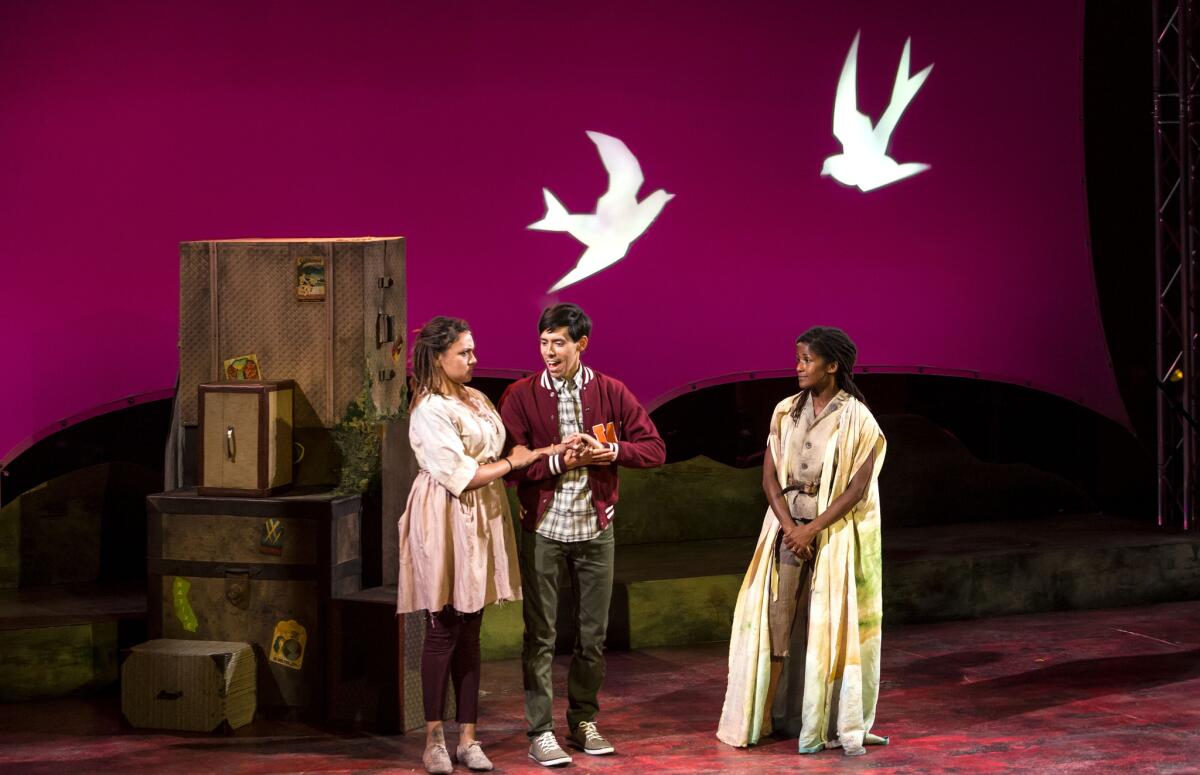Cornerstone Theater Company gives local flavors to Shakespeare

For 10 summers Cornerstone Theater Company played Johnny Appleseed up and down California. Now it’s harvest time.
For a month each year from 2004 to 2013 the communitarian Los Angeles ensemble fertilized the soil of grass-roots creativity by going places where professional theater artists seldom if ever are seen.
Now comes a nine-month journey to revisit each furrow and see what has sprouted. Cornerstone aims to re-involve each of the 10 communities it touched over those 10 summers by touring from one to the next with “California: The Tempest,” a new play that reintroduces the participatory methods that are not only the company’s trademark but a large part of its mission.
The frame is Shakespeare’s “The Tempest,” but, in keeping with Cornerstone’s goal of involving nonprofessionals in scripting and staging stories that reflect their own lives, the show creates a portrait of today’s California.
Like all playwrights commissioned by Cornerstone, Alison Carey listened before she wrote, periodically talking to groups of people in each community over the past year and a half to hear about their lives and concerns. She identified recurring themes that could unify a play and sifted the people’s stories for incidents or details that could enliven it.
“The Tempest,” one of Shakespeare’s most popular plays, is a romance about magic and the possibility of reconciliation after a grievous wrong. In this new telling, Shakespeare’s shipwrecked noblemen and sailors are a California governor and her entourage, who have the illusion that they’ve crash-landed on the state’s last habitable remnant after it has been all but totaled by an earthquake.
Weaving some of the Bard’s text into the script, Carey lets virtually all of the characters do some California dreaming, envisioning how they would rebuild their now drastically reduced state to their own liking.
Cornerstone laid the foundation for the play over the course of a decade, each year sending a different team of professional actors, directors, designers, playwrights and crafts people to a different community, along with university-level summer interns keen on learning the company’s methods.
The Cornerstone Institute Summer Residency, as it’s called, ranged from skid row in downtown Los Angeles — a stone’s throw from Cornerstone’s headquarters — to Eureka in the north. In between were sojourns in sparsely populated California burgs, far from any boulevards of art and culture. Cornerstone came to places such as Weedpatch, Lost Hills, Grayson, Holtville and Fowler, carrying its conviction that the life of any community is worth turning into art, that giving people a forum to talk about their lives inevitably will yield raw material for a play, and that with a bit of coaxing and coaching, folks who may never have been in a theater before can play supporting roles opposite a core group of veteran professional actors.
In each town, Cornerstone oversaw the scripting and performance of a new play and took down names and numbers of the local volunteers it had recruited. The company wanted to stay in touch and to have a well of talent and goodwill to dip into when the time came for a touring summation of the decade’s work.
A few hours before the curtain would rise on Cornerstone’s 10-year harvest, Luis Hernandez swept a yellow-bristled broom over the red floorboards of the temporary stage he’d helped build in the gym at Sunset School in Weedpatch, a small slice of farmland about 20 miles south of Bakersfield. Rented metal bleachers fronted the stage, giving up to 180 playgoers a close view of the action — which would include some of their friends or neighbors.
Tall and well-muscled from a recent job throwing pistachios by the bushel into bins at an orchard near his Kern County hometown of Lost Hills, stagehand Hernandez has one of the humbler jobs in the core touring company of “California: The Tempest.” He’s soft-spoken and too unassuming to have pointed out that at 21 he’s arguably one of the production’s most senior members.
Lost Hills, about 45 miles northwest of Bakersfield and populated by about 2,000 souls, was the first destination in Cornerstone’s odyssey, back in 2004. There, an 11-year-old Hernandez made his thespian debut in “Waking Up in Lost Hills: A Central California Rip Van Winkle.” The director was Bill Rauch, who led Cornerstone for its first 21 years before becoming artistic director of the Oregon Shakespeare Festival in 2007.
“I played a cross-country runner and a bowling pin,” recalled Hernandez, who wears a backward red baseball cap and sports some wiry chin hairs.
Cornerstone leaders wanted each of the tour’s 10 communities to be represented in the paid ensemble of 13 actors and a supporting crew that’s traversing the state until next June, when the last of its three-performance weekend runs will take place on the outdoor stage at California Plaza in downtown L.A. The tour that began in the boxy red Weedpatch gym, surrounded by vineyards, will end in the shadow of skyscrapers.
Hernandez, who’d taken a job at a Subway after the pistachio harvest was done, isn’t sure how Cornerstone found him after all these years. “They called my mother and let her know they were doing a reunion in Lost Hills,” he said. He auditioned for a part, but Cornerstone invited him aboard as a production assistant.
“It’s an opportunity to learn about theater, carpentry and everything we do,” Hernandez said. He’s especially eager to see San Francisco for the first time, in the tour’s penultimate stop next June.
For Elzie Alexander, landing a part in “California: The Tempest” means months of hotel living after 14 years sleeping in tents pitched on skid row. The irony of playing the state’s wealthiest political kingmaker appeals to him. So do the hotel beds and baths.
Last year Alexander, 56, had a part with Cornerstone in “Love on San Pedro,” about life on skid row. He played a cowboy and sang the Bon Jovi ballad “Wanted, Dead or Alive.”
The theater company kept his name on file, but tracking down a homeless man for a part in “California: The Tempest” was not so simple. Alexander, who’s tall with grizzled hair and beard, said that Wendell Blassingame, who screens free movies for the homeless at a skid row community center, told him that Cornerstone was looking for him, and “I got in just under the wire.” He gave his tent to a friend who needed one.
“It’s the best job I’ve been offered in the last 20 years,” Alexander said. “Fifteen hundred dollars a month is a good job for me. Some people say our hotel sucks. Where I’m coming from, everything is the Crown Plaza.”
The name Weedpatch, where the tour began in early September, may draw snickers from city slickers, but anyone who has read “The Grapes of Wrath” attentively will remember it as one of the more memorable settings in American literature and in the epic history of Depression-era California.
The community began in the 1930s as a federally operated migrant workers’ camp for homeless Okies. John Steinbeck did research for his novel in Weedpatch and portrayed it as a democratically run oasis of fair play and decent living conditions, where destitute migrants looking for farm work could find refuge from hostile local authorities and enjoy amenities such as a dance hall and indoor toilets.
The dance hall still stands, maintained as a historic site by descendants of the Okies on the campus of a still-operating housing development for today’s mainly Latino seasonal workers. It’s about a quarter of a mile down the road from Sunset School, which has its own notable chapter in Dust Bowl annals. A sympathetic schools superintendent opened the school for the migrants’ children in 1940, despite qualms from the settled community of farmers who didn’t want the impoverished newcomers getting any kind of permanent foothold. Known initially as Arvin Federal Emergency School (Arvin is a town of about 17,000 people, five miles east of Weedpatch), it attracted talented teachers who soon made it the most desirable one in the district, for Okies and longtimers alike.
History like this is a playwright’s ambrosia, but Carey said using it would have defeated her purpose. The people whose lives she had jotted down in the 10 communities as she prepared to write were not concerned with California’s past.
“People didn’t talk about history,” said the playwright, who co-founded Cornerstone in 1986 with Rauch, for whom she now runs an ambitious play-commissioning program at the Oregon Shakespeare Festival. “We asked them, ‘What do you think about California, what are your dreams for your future and the future of your town?’ They talked about their lives, and it’s my job to present that.”
Michael John Garces, who succeeded Rauch as Cornerstone’s artistic director in 2007, has shepherded the summer program his predecessor began, and now he’s in charge of the summing-up tour that will be the most ambitious project in the company’s history.
Cornerstone spends about $1.5 million in a typical year. Megan Wanlass, the managing director, said that touring “California: The Tempest,” the 2014-15 season’s only production, will increase expenses to about $2.5 million.
The nonprofit company is raising money for the tour as it goes, with potential donors invited to see the show at each stop. Little is expected from the box office, which at Weedpatch was a folding table in the gym’s lobby. Playgoers pay whatever they like, and it likely won’t go far toward paying, housing and feeding about 30 cast and crew members for about 30 weeks. Each stop involves a three-week stay for set-up, rehearsals, engaging the community, and, finally, the performances. The support staff includes a chef for communal meals that cost far less than restaurants.
“It would be nice if we could find a hotel sponsor. That would be helpful,” Wanlass said.
The premiere in Weedpatch turned out to be a long haul that went far too late into the night for an audience that lives on farming time.
Anita Garcia was among the few dozen who’d stayed past intermission on a Thursday evening, after a 90-minute first act. Stretching her legs on the gym’s outdoor patio during the break, she said that people who grew up in Weedpatch, Arvin or nearby Lamont, where she is from, had to go to Bakersfield for any kind of professional performance. She recalled school trips to see “The Nutcracker” and “Annie.”
“I think this is a good opportunity for the community,” Garcia said. “It wasn’t something we ever had here.”
Director Garces said he received plenty of comments afterward that it’s inadvisable to stage a weeknight performance in Weedpatch that goes on for three hours and stretches past 11 p.m.
“They’re getting up at 4 and 5 in the morning,” he said several days after the opening run had ended. But the missteps and hesitations — which Garces expected because there had been no time for a dress rehearsal — showed the director and playwright what they needed to winnow or speed up. Audience comments after the two subsequent Weedpatch performances weren’t about how long the play was, Garces said, but about themes that resonated.
“What came up a lot was the notion of forgiveness and how it is important in their community — the notion of someone who’s been wronged, where violence has occurred, opting out of hurting that other person.”
Tailoring “California: The Tempest” to reflect aspects of 10 communities means alterations at each stop. Next are outdoor performances Oct. 2 through 4 at a community center in the Central California town of Grayson, where about 950 people live. Then, after a four-month break, the tour will resume Feb. 5 through 7 with its Los Angeles area debut at the Cesar Chavez Learning Academies in San Fernando.
“This show is about change,” Garces said. “As we learn and discover things, there are lots of possibilities.”
Twitter: @boehmm
More to Read
The biggest entertainment stories
Get our big stories about Hollywood, film, television, music, arts, culture and more right in your inbox as soon as they publish.
You may occasionally receive promotional content from the Los Angeles Times.











